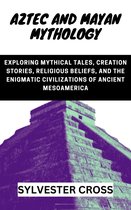Lost Pyramids of Mesoamerica Ebook Tooltip Ebooks kunnen worden gelezen op uw computer en op daarvoor geschikte e-readers.
Afbeeldingen
Sla de afbeeldingen overArtikel vergelijken
- Engels
- E-book
- 9798201325534
- 27 augustus 2022
- Epub zonder kopieerbeveiliging (DRM)
Samenvatting
While most visitors to Mexico visit one of the great Mayan cities, it is worth visiting some of the lesser-known ruins like Mayapan and Balamku. Mayapan is an ancient Maya city in the northern Yucatan Peninsula of Mexico. The site has a long history, with its first occupation dating back to at least 900 BC and its last occupation dating to around 1450 AD. The word "Mayapan" means "Hill of the Jaguar." The name refers to the shape of one of three hills that formed it - this hill was called Pa Chan (Place of the Jaguar). It was here that a jaguar deity named Chac reigned. When Chac left his post as a god of rain, the rain ceased falling on earth for four years until he returned; during this time, people were forced to irrigate their crops by hand or die from thirst if they failed at growing corn without rainwater overflow from nearby lakes and rivers.
The city of Teotihuacan is one of the most important archaeological sites in Mexico. It was the center of a civilization at its peak around the 1st century B.C. and was abandoned around 650 AD, leaving behind an impressive collection of pyramids and other structures. As you explore this site, you will discover how these ancient people lived and what they left behind for us to admire today.
Tulum is a small town on the coast of the Yucatán Peninsula, south of Cancún. It may not be your first choice if you look for beaches and relaxation. But if you want to see some fantastic architecture—and walk in the footsteps of the Maya—you should definitely make plans to visit Tulum.
The Mayans built the city between 1200 and 1450 CE (Common Era) as a seaport for trading with other cultures in Mesoamerica. Its popularity rose with increased trade throughout Mexico during this period; however, it fell into disrepair after Spanish colonization began around 1519 CE when conquistador Hernán Cortés took control over what had been largely autonomous states up until then. The buildings are made from limestone quarried from nearby cliffs and from sandstone blocks that were likely carried from much further away by barge or canoe along rivers and lakes (since there were no roads).
The city of Uxmal is a magnificent example of the Puuc style, with its buildings built of fine stuccoed brickwork. As you explore the site, you can see how closely related it is to Chichén Itzá and other major Maya sites in the region. The Pyramid of the Magician (also known as El Castillo) - is a fantastic pyramid building with 4 sides, each having 91 steps and each step 7 feet tall for a total height of 65 feet! House of Turtles (or Casa del Adivino) - this building has beautiful decorations both inside and out depicting turtles in different positions; some say that these turtles represent wisdom or knowledge.
Tikal is the largest Mayan ruin in Guatemala and is a UNESCO World Heritage Site. The city was the capital of the Maya kingdom of the same name and one of their most potent cities, dating back to at least 200 B.C., if not earlier. It was abandoned by the Maya around 900 A.D., but its temples still tower over the jungle floor today—some are even taller than they were when they were first built!
Palenque, Crown of the North, is one of the most critical sites in the Maya world. Palenque was once a thriving city and capital of one of Mexico's most powerful states. It boasts some of the most impressive ruins on this list. It was first discovered by a German explorer in 1719 while looking for a site to build his own city. The main pyramid at Palenque rises over 70 meters (230 ft) into the air, and its steps are steep enough to pause even hardened explorers when climbing them! There are also two smaller temples nearby and many smaller statues depicting jaguars – these symbolize power for humans and gods alike.
Productspecificaties
Inhoud
- Taal
- en
- Bindwijze
- E-book
- Oorspronkelijke releasedatum
- 27 augustus 2022
- Ebook Formaat
- Epub zonder kopieerbeveiliging (DRM)
Betrokkenen
- Hoofdauteur
- RHANDEL LOPEZ
Lees mogelijkheden
- Lees dit ebook op
- Android (smartphone en tablet) | Kobo e-reader | Desktop (Mac en Windows) | iOS (smartphone en tablet) | Windows (smartphone en tablet)
Overige kenmerken
- Studieboek
- Nee
EAN
- EAN
- 9798201325534
Je vindt dit artikel in
- Taal
- Engels
- Boek, ebook of luisterboek?
- Ebook
- Beschikbaar in Kobo Plus
- Beschikbaar in Kobo Plus
- Beschikbaarheid
- Leverbaar
Kies gewenste uitvoering
Prijsinformatie en bestellen
De prijs van dit product is 9 euro en 49 cent.- E-book is direct beschikbaar na aankoop
- E-books lezen is voordelig
- Dag en nacht klantenservice
- Veilig betalen
Rapporteer dit artikel
Je wilt melding doen van illegale inhoud over dit artikel:
- Ik wil melding doen als klant
- Ik wil melding doen als autoriteit of trusted flagger
- Ik wil melding doen als partner
- Ik wil melding doen als merkhouder
Geen klant, autoriteit, trusted flagger, merkhouder of partner? Gebruik dan onderstaande link om melding te doen.








